Xuanyu Zhang
Q-Insight: Understanding Image Quality via Visual Reinforcement Learning
Mar 28, 2025Abstract:Image quality assessment (IQA) focuses on the perceptual visual quality of images, playing a crucial role in downstream tasks such as image reconstruction, compression, and generation. The rapid advancement of multi-modal large language models (MLLMs) has significantly broadened the scope of IQA, moving toward comprehensive image quality understanding that incorporates content analysis, degradation perception, and comparison reasoning beyond mere numerical scoring. Previous MLLM-based methods typically either generate numerical scores lacking interpretability or heavily rely on supervised fine-tuning (SFT) using large-scale annotated datasets to provide descriptive assessments, limiting their flexibility and applicability. In this paper, we propose Q-Insight, a reinforcement learning-based model built upon group relative policy optimization (GRPO), which demonstrates strong visual reasoning capability for image quality understanding while requiring only a limited amount of rating scores and degradation labels. By jointly optimizing score regression and degradation perception tasks with carefully designed reward functions, our approach effectively exploits their mutual benefits for enhanced performance. Extensive experiments demonstrate that Q-Insight substantially outperforms existing state-of-the-art methods in both score regression and degradation perception tasks, while exhibiting impressive zero-shot generalization to comparison reasoning tasks. Code will be available at https://github.com/lwq20020127/Q-Insight.
SecureGS: Boosting the Security and Fidelity of 3D Gaussian Splatting Steganography
Mar 08, 2025Abstract:3D Gaussian Splatting (3DGS) has emerged as a premier method for 3D representation due to its real-time rendering and high-quality outputs, underscoring the critical need to protect the privacy of 3D assets. Traditional NeRF steganography methods fail to address the explicit nature of 3DGS since its point cloud files are publicly accessible. Existing GS steganography solutions mitigate some issues but still struggle with reduced rendering fidelity, increased computational demands, and security flaws, especially in the security of the geometric structure of the visualized point cloud. To address these demands, we propose a SecureGS, a secure and efficient 3DGS steganography framework inspired by Scaffold-GS's anchor point design and neural decoding. SecureGS uses a hybrid decoupled Gaussian encryption mechanism to embed offsets, scales, rotations, and RGB attributes of the hidden 3D Gaussian points in anchor point features, retrievable only by authorized users through privacy-preserving neural networks. To further enhance security, we propose a density region-aware anchor growing and pruning strategy that adaptively locates optimal hiding regions without exposing hidden information. Extensive experiments show that SecureGS significantly surpasses existing GS steganography methods in rendering fidelity, speed, and security.
OmniGuard: Hybrid Manipulation Localization via Augmented Versatile Deep Image Watermarking
Dec 02, 2024



Abstract:With the rapid growth of generative AI and its widespread application in image editing, new risks have emerged regarding the authenticity and integrity of digital content. Existing versatile watermarking approaches suffer from trade-offs between tamper localization precision and visual quality. Constrained by the limited flexibility of previous framework, their localized watermark must remain fixed across all images. Under AIGC-editing, their copyright extraction accuracy is also unsatisfactory. To address these challenges, we propose OmniGuard, a novel augmented versatile watermarking approach that integrates proactive embedding with passive, blind extraction for robust copyright protection and tamper localization. OmniGuard employs a hybrid forensic framework that enables flexible localization watermark selection and introduces a degradation-aware tamper extraction network for precise localization under challenging conditions. Additionally, a lightweight AIGC-editing simulation layer is designed to enhance robustness across global and local editing. Extensive experiments show that OmniGuard achieves superior fidelity, robustness, and flexibility. Compared to the recent state-of-the-art approach EditGuard, our method outperforms it by 4.25dB in PSNR of the container image, 20.7% in F1-Score under noisy conditions, and 14.8% in average bit accuracy.
Understanding Layer Significance in LLM Alignment
Oct 23, 2024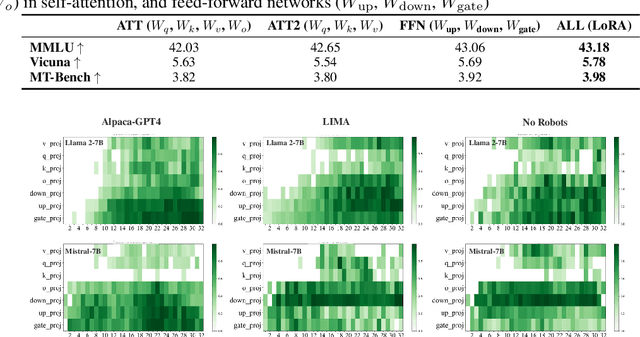
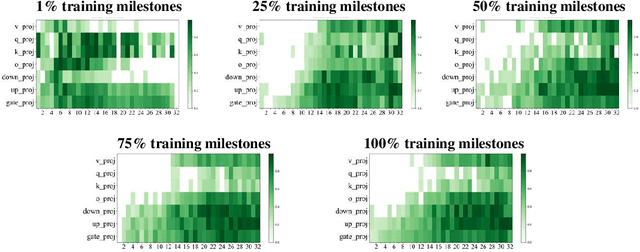


Abstract:Aligning large language models (LLMs) through fine-tuning is essential for tailoring them to specific applications. Therefore, understanding what LLMs learn during the alignment process is crucial. Recent studies suggest that alignment primarily adjusts a model's presentation style rather than its foundational knowledge, indicating that only certain components of the model are significantly impacted. To delve deeper into LLM alignment, we propose to identify which layers within LLMs are most critical to the alignment process, thereby uncovering how alignment influences model behavior at a granular level. We propose a novel approach to identify the important layers for LLM alignment (ILA). It involves learning a binary mask for each incremental weight matrix in the LoRA algorithm, indicating the significance of each layer. ILA consistently identifies important layers across various alignment datasets, with nearly 90% overlap even with substantial dataset differences, highlighting fundamental patterns in LLM alignment. Experimental results indicate that freezing non-essential layers improves overall model performance, while selectively tuning the most critical layers significantly enhances fine-tuning efficiency with minimal performance loss.
FakeShield: Explainable Image Forgery Detection and Localization via Multi-modal Large Language Models
Oct 03, 2024
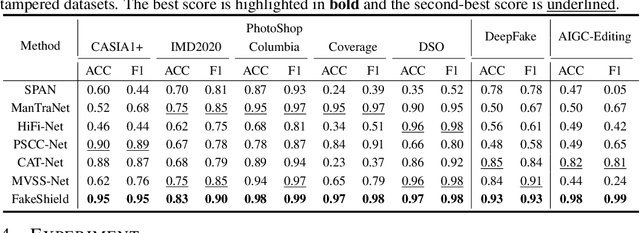
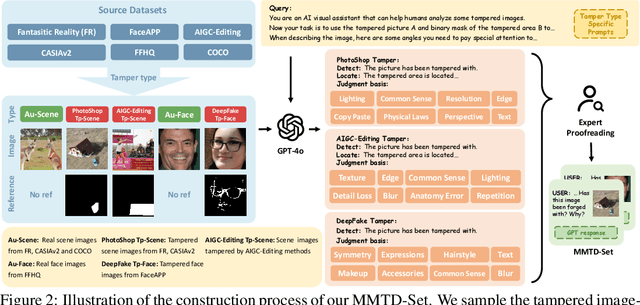

Abstract:The rapid development of generative AI is a double-edged sword, which not only facilitates content creation but also makes image manipulation easier and more difficult to detect. Although current image forgery detection and localization (IFDL) methods are generally effective, they tend to face two challenges: \textbf{1)} black-box nature with unknown detection principle, \textbf{2)} limited generalization across diverse tampering methods (e.g., Photoshop, DeepFake, AIGC-Editing). To address these issues, we propose the explainable IFDL task and design FakeShield, a multi-modal framework capable of evaluating image authenticity, generating tampered region masks, and providing a judgment basis based on pixel-level and image-level tampering clues. Additionally, we leverage GPT-4o to enhance existing IFDL datasets, creating the Multi-Modal Tamper Description dataSet (MMTD-Set) for training FakeShield's tampering analysis capabilities. Meanwhile, we incorporate a Domain Tag-guided Explainable Forgery Detection Module (DTE-FDM) and a Multi-modal Forgery Localization Module (MFLM) to address various types of tamper detection interpretation and achieve forgery localization guided by detailed textual descriptions. Extensive experiments demonstrate that FakeShield effectively detects and localizes various tampering techniques, offering an explainable and superior solution compared to previous IFDL methods.
Turning Trash into Treasure: Accelerating Inference of Large Language Models with Token Recycling
Aug 16, 2024



Abstract:The rapid growth in the parameters of large language models (LLMs) has made inference latency a fundamental bottleneck, limiting broader application of LLMs. Speculative decoding represents a lossless approach to accelerate inference through a guess-and-verify paradigm, leveraging the parallel capabilities of modern hardware. Some speculative decoding methods rely on additional structures to guess draft tokens, such as small models or parameter-efficient architectures, which need extra training before use. Alternatively, retrieval-based train-free techniques build libraries from pre-existing corpora or by n-gram generation. However, they face challenges like large storage requirements, time-consuming retrieval, and limited adaptability. Observing that candidate tokens generated during the decoding process are likely to reoccur in future sequences, we propose Token Recycling. This approach stores candidate tokens in an adjacency matrix and employs a breadth-first search (BFS)-like algorithm on the matrix to construct a draft tree. The tree is then validated through tree attention. New candidate tokens from the decoding process are then used to update the matrix. Token Recycling requires \textless2MB of additional storage and achieves approximately 2x speedup across all sizes of LLMs. It significantly outperforms existing train-free methods by 30\% and even a training method by 25\%. It can be directly applied to any existing LLMs and tasks without the need for adaptation.
Make Some Noise: Unlocking Language Model Parallel Inference Capability through Noisy Training
Jun 25, 2024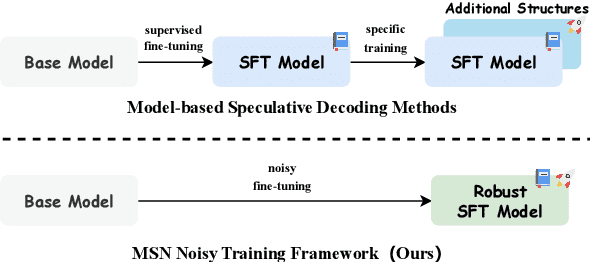
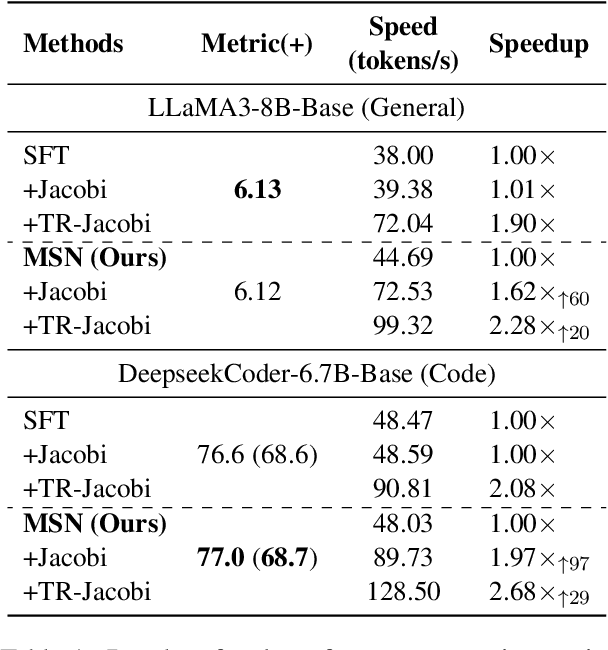
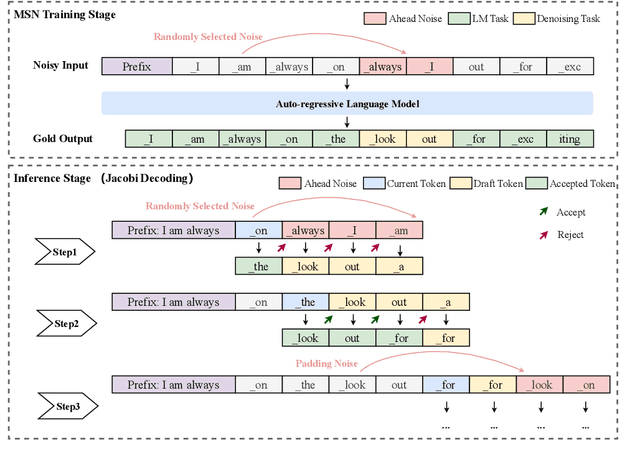
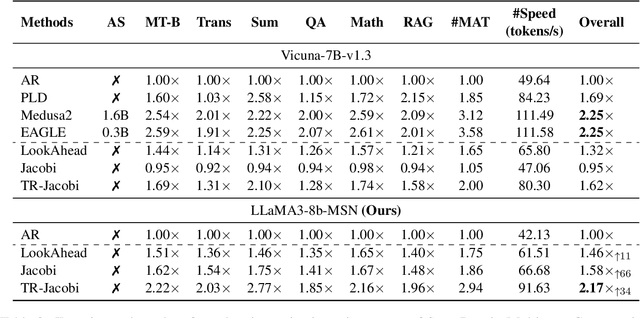
Abstract:Existing speculative decoding methods typically require additional model structure and training processes to assist the model for draft token generation. This makes the migration of acceleration methods to the new model more costly and more demanding on device memory. To address this problem, we propose the Make Some Noise (MSN) training framework as a replacement for the supervised fine-tuning stage of the large language model. The training method simply introduces some noise at the input for the model to learn the denoising task. It significantly enhances the parallel decoding capability of the model without affecting the original task capability. In addition, we propose a tree-based retrieval-augmented Jacobi (TR-Jacobi) decoding strategy to further improve the inference speed of MSN models. Experiments in both the general and code domains have shown that MSN can improve inference speed by 2.3-2.7x times without compromising model performance. The MSN model also achieves comparable acceleration ratios to the SOTA model with additional model structure on Spec-Bench.
Protect-Your-IP: Scalable Source-Tracing and Attribution against Personalized Generation
May 26, 2024Abstract:With the advent of personalized generation models, users can more readily create images resembling existing content, heightening the risk of violating portrait rights and intellectual property (IP). Traditional post-hoc detection and source-tracing methods for AI-generated content (AIGC) employ proactive watermark approaches; however, these are less effective against personalized generation models. Moreover, attribution techniques for AIGC rely on passive detection but often struggle to differentiate AIGC from authentic images, presenting a substantial challenge. Integrating these two processes into a cohesive framework not only meets the practical demands for protection and forensics but also improves the effectiveness of attribution tasks. Inspired by this insight, we propose a unified approach for image copyright source-tracing and attribution, introducing an innovative watermarking-attribution method that blends proactive and passive strategies. We embed copyright watermarks into protected images and train a watermark decoder to retrieve copyright information from the outputs of personalized models, using this watermark as an initial step for confirming if an image is AIGC-generated. To pinpoint specific generation techniques, we utilize powerful visual backbone networks for classification. Additionally, we implement an incremental learning strategy to adeptly attribute new personalized models without losing prior knowledge, thereby enhancing the model's adaptability to novel generation methods. We have conducted experiments using various celebrity portrait series sourced online, and the results affirm the efficacy of our method in source-tracing and attribution tasks, as well as its robustness against knowledge forgetting.
GS-Hider: Hiding Messages into 3D Gaussian Splatting
May 24, 2024Abstract:3D Gaussian Splatting (3DGS) has already become the emerging research focus in the fields of 3D scene reconstruction and novel view synthesis. Given that training a 3DGS requires a significant amount of time and computational cost, it is crucial to protect the copyright, integrity, and privacy of such 3D assets. Steganography, as a crucial technique for encrypted transmission and copyright protection, has been extensively studied. However, it still lacks profound exploration targeted at 3DGS. Unlike its predecessor NeRF, 3DGS possesses two distinct features: 1) explicit 3D representation; and 2) real-time rendering speeds. These characteristics result in the 3DGS point cloud files being public and transparent, with each Gaussian point having a clear physical significance. Therefore, ensuring the security and fidelity of the original 3D scene while embedding information into the 3DGS point cloud files is an extremely challenging task. To solve the above-mentioned issue, we first propose a steganography framework for 3DGS, dubbed GS-Hider, which can embed 3D scenes and images into original GS point clouds in an invisible manner and accurately extract the hidden messages. Specifically, we design a coupled secured feature attribute to replace the original 3DGS's spherical harmonics coefficients and then use a scene decoder and a message decoder to disentangle the original RGB scene and the hidden message. Extensive experiments demonstrated that the proposed GS-Hider can effectively conceal multimodal messages without compromising rendering quality and possesses exceptional security, robustness, capacity, and flexibility. Our project is available at: https://xuanyuzhang21.github.io/project/gshider.
Diffusion-Based Hierarchical Image Steganography
May 19, 2024
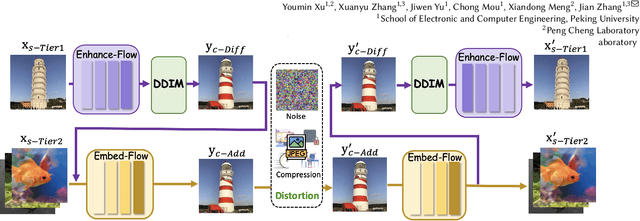


Abstract:This paper introduces Hierarchical Image Steganography, a novel method that enhances the security and capacity of embedding multiple images into a single container using diffusion models. HIS assigns varying levels of robustness to images based on their importance, ensuring enhanced protection against manipulation. It adaptively exploits the robustness of the Diffusion Model alongside the reversibility of the Flow Model. The integration of Embed-Flow and Enhance-Flow improves embedding efficiency and image recovery quality, respectively, setting HIS apart from conventional multi-image steganography techniques. This innovative structure can autonomously generate a container image, thereby securely and efficiently concealing multiple images and text. Rigorous subjective and objective evaluations underscore our advantage in analytical resistance, robustness, and capacity, illustrating its expansive applicability in content safeguarding and privacy fortification.
 Add to Chrome
Add to Chrome Add to Firefox
Add to Firefox Add to Edge
Add to Edge